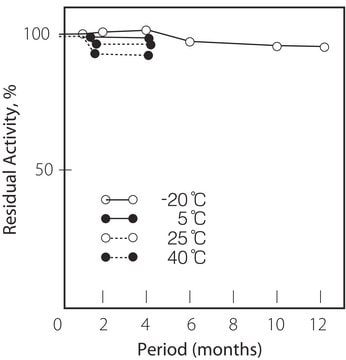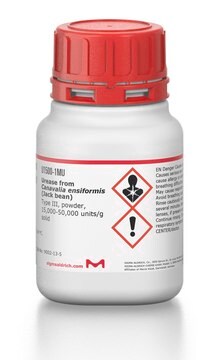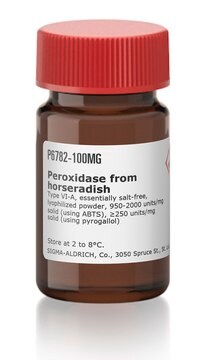C2409
Creatinase from microorganisms
lyophilized powder, ≥4 units/mg solid
Synonym(s):
Creatine Amidinohydrolase
About This Item
Recommended Products
biological source
bacterial (Actinobacillus spp.)
form
lyophilized powder
specific activity
≥4 units/mg solid
mol wt
~100 kDa
storage temp.
−20°C
General description
Application
Biochem/physiol Actions
Physical properties
Michaelis constant: 1.9 x 10‾2M (Creatine)
Structure: 2 subunits per mole of enzyme
Inhibitors: Cu++, Hg++, Ag+
Optimum pH: 8.0
Optimum temp: 40°C
pH Stability: pH 5.5 − 9.0 (25°C, 16hr)
Thermal stability: Below 50°C (pH 7.5, 30 min)
Unit Definition
Physical form
Signal Word
Danger
Hazard Statements
Precautionary Statements
Hazard Classifications
Resp. Sens. 1
Storage Class Code
11 - Combustible Solids
WGK
WGK 1
Flash Point(F)
Not applicable
Flash Point(C)
Not applicable
Personal Protective Equipment
Regulatory Listings
Regulatory Listings are mainly provided for chemical products. Only limited information can be provided here for non-chemical products. No entry means none of the components are listed. It is the user’s obligation to ensure the safe and legal use of the product.
JAN Code
C2409-500UN:
C2409-1KU:
C2409-BULK:
C2409-100UN:
Certificates of Analysis (COA)
Search for Certificates of Analysis (COA) by entering the products Lot/Batch Number. Lot and Batch Numbers can be found on a product’s label following the words ‘Lot’ or ‘Batch’.
Already Own This Product?
Find documentation for the products that you have recently purchased in the Document Library.
Customers Also Viewed
Our team of scientists has experience in all areas of research including Life Science, Material Science, Chemical Synthesis, Chromatography, Analytical and many others.
Contact Technical Service









